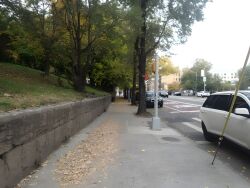Michel Triangle
Michel Triangle
In 1940, this triangle was named to honor August Michel (1900-1918), a native of the Bronx famous for being one of the smallest men ever in the United States Army. Originally rejected by the army because he was too short for regulations, Michel did “stretching” exercises and eventually met the height requirement. Tragically, Michel died at the age of 18 at Camp Bowie, Texas, while serving his country during the World War I.
Michel entered the Army on April 22, 1918. He died during the great Influenza Plague that hit the United States in 1918 – the worst epidemic in our country’s history, it killed more Americans than did all the wars of the 20th century. Michel, in a display of compassion and selflessness, thought he was less ill than some of the other soldiers, and gave up his bed in the hospital. He suffered a relapse and died on October 22, 1918.
Michel Triangle is bounded by Clay Avenue, Webster Avenue, and East 165th Street. The road that is now Clay Avenue, between 164th and 167th Streets, was part of the old General Staats Morris’ racetrack that had been laid out in 1750 and survived through the mid-1800s. Clay Avenue was also known as Elliot Street where it now runs along Claremont Park (formerly known as the Zborowski estate “Claremont”), and as Crestline Street from East 169th to East 171st Street. While Clay Avenue is believed to honor the great American senator Henry Clay (1777-1852). An anecdotal story has it that a swamp to the west of the Zborowski estate had caused developers so much trouble that, when they found clay instead of mud, they gratefully named the avenue in honor of their project-saving discovery.
Webster Avenue was surveyed after the Civil War and lengthened up to East 184th Street in 1879. Though many believe Webster Avenue was named for American politician and orator Daniel Webster (1782-1852.), it is more likely true that it was named for either (or both) Albert L. Webster, an engineer in the Department of Public Works at the time of the avenue’s lengthening, or Joseph O.B. Webster, the surveyor of the project.
This property was acquired by condemnation for the building of a street by the city on December 24, 1897. The park remained nameless until the city chose to name it in honor of Private August Michel, the community’s tiny yet brave fallen son.
Check out your park's Vital Signs
Clean & Safe
Green & Resilient
Empowered & Engaged Users
Share your feedback or learn more about how this park is part of a
Vital Park System





